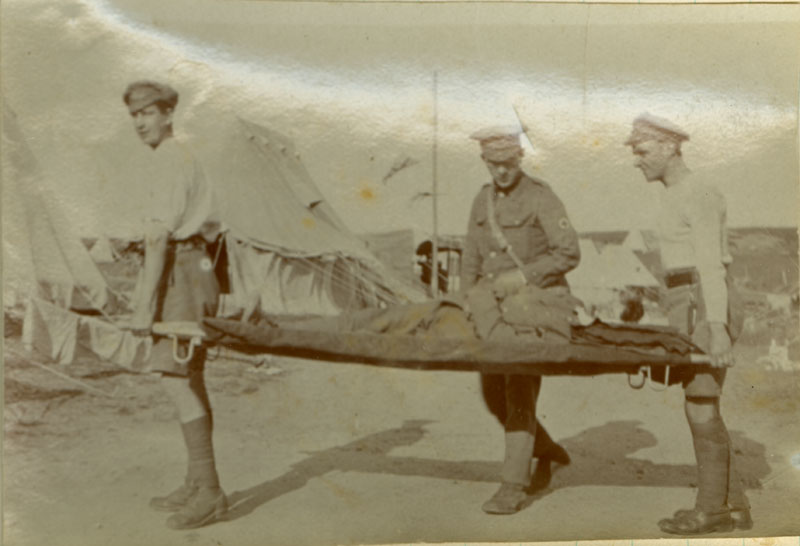Above: Burton, Barton, and Grimco.” [Likely taken at the 28th Casualty Clearing Station at Karasouli, Greece, ca. 1917] (From William Pizzey’s military service photograph album, SPRA 2018.004.138)
The outbreak of the First World War brought about the need for much change and innovation in the medical field. Ambulances, antiseptic, and anesthesia were all crude (or non-existent) elements of medicine prior to the war, but became sophisticated, indispensable instruments in the saving of millions of lives.
Transporting and caring for such masses of wounded soldiers was something the world had never dealt with before. Through trial and error, a system was established: a network of ambulance wagons, trains, and ships; dressing stations, clearing stations, and general hospitals. This system was dubbed “The Ladder of Good Progress.” For Canadian soldiers, the journey did not end at the hospitals in England. Between March 1917 and November 1918, more than 30,000 Canadians were invalided home via hospital ships and ambulance transports. Among these numbers were at least 70 men from the South Peace, along with a local nurse who served aboard a hospital ship.
A journey across the Atlantic was a risky endeavour. The German navy had declared unrestricted submarine warfare in January 1917, intentionally targeting hospital ships. Diseases such as scurvy, cholera, and—of course—the flu were also a potential threat. However, as a result of the careful screening that took place before a patient was cleared to board a hospital ship, only one patient died of illness while en route to Canada.
Of the 70+ South Peace soldiers who were transported home while the war was still on, all returned safely without notable incident. However, a few journeyed on ships that would sink later in the war. Private Riley LeRoy Gill, who homesteaded near La Glace, was one of the men who experienced such a “near miss.”
Riley was originally from Nebraska, but came to the area in 1915, which was also when he enlisted. Less than a month after arriving at the front lines, Riley was shot in his left leg, fracturing his tibia. Two operations were performed at a hospital in Boulogne before he was transported to England, where he underwent many more surgeries in attempts to save his leg.
While in a convalescent home in Uxbridge, doctors found Riley to be suffering from shell shock; they decided that he would be invalided home to Canada. On June 18, 1917, he departed from Liverpool aboard the HMHS Letitia, which was staffed with a Merchant Marine crew and Canadian Army Medical Corps officers. They arrived in Halifax on June 29, the final time the Letitia would dock in Canada. On her next voyage, the Letitia was caught in a thick fog and ran aground near Halifax. All patients were rescued, but one crew member drowned. In total, the Letitia had transported 2,635 patients over the course of five voyages. As for Riley, he had been safely transported to the Strathcona Military Hospital in Edmonton, where he would spend a year and eight months. Unfortunately, he was in a car accident while a patient there, and suffered a fractured left femur, shortening his leg by more than two inches. Riley was discharged from the army in May of 1919, and died on January 1, 1955.
Private James McGovern, who had received gunshot wounds to his head and thigh at the Somme in October 1916, experienced an even closer escape. Though the wounds healed, Jim began to suffer from anorexia, fevers, and general weakness. No longer fit for service, he was invalided home in 1918. He left Liverpool on June 6 aboard the infamous HMHS Llandovery Castle, and arrived in Halifax on June 17, 1918. Only ten days later, on its return trip to England, the Llandovery Castle was torpedoed and sunk by a German sub off the Irish coast. Out of the 258 crew members and medical personnel on board, only twenty-four survived; some had drowned, and others had been gunned down by the German navy whilst awaiting rescue in the lifeboats. The world was incensed at these atrocities, but the enemy showed no remorse. Desperate to prevent this from happening again, the Allies revoked the commissions of hospital ships and rather called them “ambulance transports,” which, by the rules of warfare, allowed them to be painted as troop ships and armed with guns. Following these changes, only one allied ship was lost due to enemy activity. Private Jim McGovern, safe in Canada, was discharged in October 1918 and returned to his homestead at Red Willow. He passed away in 1938 at the age of 59.
When the war ended and hospital ships were no longer needed, many of the surviving vessels were returned to their former careers as passenger liners, mail ships, and cargo transports. Sadly, it would not be long before they would again be called upon to carry troops to war and back again.
This article was contributed by Archives volunteer Kaylee Bussemeier. Kaylee researched First World War veterans of the South Peace in order to write biographies for the Archives’ online Soldier’s Memorial. It first appeared in the December 2019 issue of Telling Our Stories.
